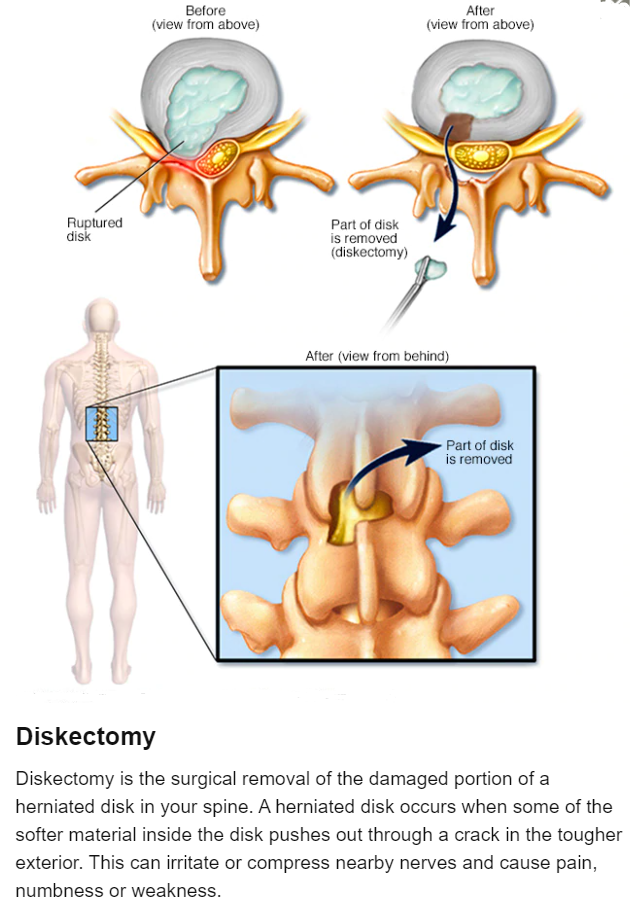
DISKECTOMY
Share

OVERVIEW
Diskectomy is a surgical procedure to remove the damaged portion of a herniated disk in your spine. A herniated disk can irritate or compress nearby nerves. Diskectomy is most effective for treating pain that radiates down your arms or legs.
The procedure is less helpful for treating actual back pain or neck pain. Most people who have back pain or neck pain find relief with more-conservative treatments, such as physical therapy.
Your doctor may suggest Diskectomy if conservative, nonsurgical treatments haven't worked or if your symptoms worsen. There are several ways to perform a discectomy. Many surgeons now prefer minimally invasive discectomy, which uses small incisions and a tiny video camera for viewing the procedure.
Why it's done
A Diskectomy is performed to relieve the pressure a herniated disk (also called a slipped, ruptured or bulging disk or disk prolapse) places on a spinal nerve. A herniated disk occurs when some of the softer material inside the disk pushes out through a crack in the tougher exterior.

You have trouble standing or walking because of nerve weakness.
Conservative treatment, such as physical therapy or steroid injections, fails to improve your symptoms after six to 12 weeks.
Pain radiating into your buttocks, legs, arms or chest becomes too much to manage.
Risks
Diskectomy is considered a safe procedure. But as with any surgery, diskectomy carries a risk of complications. Potential complications include:
- Bleeding
- Infection
- Leaking spinal fluid
- Injury to blood vessels or nerves in and around the spine
How you prepare
You'll likely need to avoid eating and drinking for a certain amount of time before surgery. If you take blood-thinning medications, you may need to adjust your dosing schedule before surgery. Your doctor will give you specific instructions.
What you can expect
During Diskectomy
Surgeons usually perform Diskectomy using general anesthesia, so you're unconscious during the procedure. Small amounts of spinal bone and ligament may be removed to gain access to the herniated disk.
Ideally, just the fragment of disk that is pinching the nerve is removed, relieving the pressure but leaving most of the disk intact.
If the entire disk must be taken out, your surgeon may need to fill the space with a piece of bone — taken from a deceased donor or from your own pelvis — or a synthetic bone substitute. The adjoining vertebrae are then fused together with metal hardware.
After Diskectomy
After surgery, you're moved to a recovery room where the health care team watches for complications from the surgery and anesthesia. You may be healthy enough to go home the same day you have surgery, although a short hospital stay may be necessary — particularly if you have any serious pre-existing medical conditions.
Depending on the amount of lifting, walking and sitting your job involves, you may be able to return to work in two to six weeks. If you have a job that includes heavy lifting or operating heavy machinery, your doctor may advise you to wait six to eight weeks before returning to work.
Results
Diskectomy reduces herniated disk symptoms in most people who have clear signs of nerve compression, such as radiating pain. However, Diskectomy may not be a permanent cure, because it doesn't do anything to reverse the process that allowed the disk to become herniated in the first place.
To avoid re-injuring your spine, your doctor may recommend weight loss, prescribe a low-impact exercise program, and ask that you limit some activities that involve extensive or repetitive bending, twisting or lifting.
For more information, please visit www.medicalsalesbusinesscoach.com

